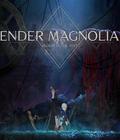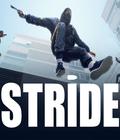Stride is an action platformer in VR that tries to emulate the thrill of parkouring over towering rooftops where every misstep could mean a long fall down. After some positive reception following its PC Early Access release, the Quest 2 port arrived in August 2021. Stride on the Quest 2 can't directly compete with its PC counterpart just yet, but it's a close and faithful conversion that plays incredibly well — most of the time.
If you've ever thought that playing Mirror's Edge in VR would be cool, Stride feels like the next best thing. In Stride, players move forward while trying to forge the best path from a selection of walls, rooftops, grappling hooks, and zip lines. Whether you're running along walls or sliding under them, Stride is all about movement and momentum, and it found a way to feel quite natural. There is no story content or backdrop for the game yet; it's just you standing on the edge of a rooftop and trying to make your way across. Simplicity is not synonymous with being easy, though. Stride is quite a workout that will have you sweating under your VR goggles in no time. What makes Stride fun is that the controls feel incredible once you get the hang of them.
Stride requires both button and movement inputs for traversal. The left stick is for moving in a particular direction, the A button is for jumping in place, and the shoulder buttons grab ledges or the occasional gun. Those controls alone move at a snail's pace, so you need more to build up momentum. Swinging both arms in a running motion makes you gain speed, and swinging your arms while leaping ensures you jump higher and farther. You can also hold onto ledges and pull yourself up. While these seem like trivial control choices, using your hands to traverse the environment works remarkably well.
After the initial tutorial and a few test runs, I was quickly acquainted with the ins and outs of controlling my character and how to move quickly and effectively. Leaping over gaps with your arms swinging is a rewarding feeling that Stride pulls off with ease. As you master the learning curve, you'll eventually be able to fluently weave together different moves to master different hurdles, such as ducking to slide through a narrow gap, tiptoeing on small ledges, and running along walls only to leap to a higher building. You're constantly engaged in assessing where you might have the best or quickest way up and ahead, and it's as exhilarating as it is exhausting. If you were looking for a casual workout while gaming, this is a good contender.
Stride isn't perfect, though. A lot of what you do is time-based, so getting through a stage quickly is paramount to success, but I ran into some frustrations, particularly with climbing ledges. When hanging on a ledge and pulling yourself up, you must eventually let go to proceed. If you don't or time it incorrectly, you're often on your way back down. This also got better with practice, but there were a lot of situations where I couldn't pull up on a ledge or wall-run when I thought I should've been able to. They happened often enough to sincerely frustrate me as I tried clearing a timed level for the hundredth time, often failing at the same spot due to not getting the timing or angle right. It's a small blemish on an otherwise fun control scheme and gameplay mechanic.
Stride is a very basic experience at this time, consisting of only three modes on the Quest, with more content updates planned. The PC version already has a basic multiplayer mode, which is reportedly coming to the Quest, as well as a story mode that should hit both platforms at some point.
For now, players have the choice between Endless, Timed, and Arena which all offer slightly different ways to engage with the game. Endless is exactly what it sounds like: endless parkour where the course behind you is slowly engulfed in black. If you're overtaken by it, you lose. The further you get in Endless mode, the better the score on the leaderboard and the tougher the obstacles. There are also some handy power-ups to provide an edge. The game eventually introduces armed enemies and drones, which you have to take out with a pistol while running. There's also a handy slow-mo button that can make the brief firefights feel epic as you make your way jumping through the concrete jungle. The shooting mechanics aren't evolved yet, with enemies that are sometimes tough to hit and with little to indicate from a distance if you're hitting them, but they introduce an element of danger to your parkour. If the game doesn't feel difficult enough, you can add multipliers to make the next run harder and to boost your score.
A much safer spot to test out moves are the Timed challenges, which range from Easy to Hard, which are finite tracks that you must finish within a certain time for a star rating. Thanks to the ramping difficulty and confined course, these tracks were fun to complete, but there are only 12 stages. Since there are further updates planned, I hope more may be added in the future.
The final mode is Arena, which features a small neighborhood area with enemies and objectives. Except for its parkour theme, Stride doesn't have much to do with Mirror's Edge, but the level design and traversal in Arenas are the closest it gets, and that is absolutely intended as a compliment. At the same time, all three currently available modes don't do much more than repackage the core gameplay into some neat variations that, after some time, wear off in excitement. There isn't that much to do yet in Stride, regardless of how strong its parkour controls and gameplay may be. It's a good foundation that can be built upon with future updates because there is a ton of potential that is currently underutilized. Then again, for the price of $15, Stride is a great title to expand one's VR library, even with the currently limited content offering.
Not much was lost in converting Stride from the PC to the Quest. Textures are lower resolution, and a few other corners had to be visibly cut here and there, but overall, both games look and perform pretty similar. I have not encountered extensive frame drops or crashes on the Quest 2, but the game did freeze on me at startup, and it could not be resolved until I reinstalled the entire app.
Stride runs and looks great. It also features a slew of comfort options because the game is quite intense in VR. For the intensity of the gameplay, it does a great job, which stems from the way to controls. Since your body movements match the action in the game, nausea and motion sickness should be reduced in comparison to more stationary experiences. That means that most players should be able to enjoy Stride, even if they require a few comfort options to be active. Whether it's a special turning mode or blinders, the usual options are available and should ensure that almost anyone can enjoy Stride. There is also a seated option if you need it, but that didn't feel natural given the required hand motions to traverse. It's an option, though.
Overall, Stride feels more like a concept title than a real one, given its very limited available content that centers around its core mechanic. That doesn't matter too much because the controls and gameplay are superb, except for a few minor inconsistencies. It's not a must-have title yet, but since a story and multiplayer update are still to come, Stride may have what it takes to become a highly addictive and fun parkour simulator in VR. If you have a Quest at your disposal, Stride is certainly worth a look.
Score: 7.5/10
More articles about Stride












 Stride is a high-octane VR game that fuses parkour and combat to create one of the most nail-biting virtual reality experiences available.
Stride is a high-octane VR game that fuses parkour and combat to create one of the most nail-biting virtual reality experiences available.





























